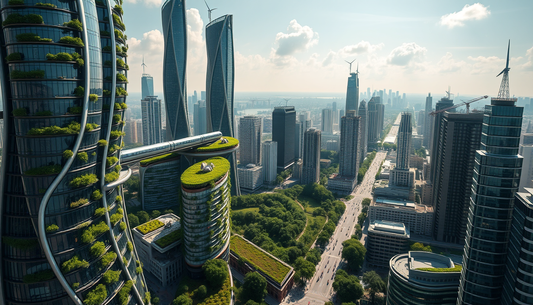Climate change is one of the greatest challenges facing humanity today. Its impacts, such as rising sea levels, more extreme weather events, and loss of biodiversity, threaten our way of life and the future of the planet. In this context, sustainable architecture emerges as a key solution to counteract the effects of climate change.
The Importance of Sustainable Architecture
Sustainable architecture, also known as "green building", is a design approach that aims to reduce the environmental impact of buildings throughout their life cycle, from construction to use and decommissioning. This type of architecture focuses on energy efficiency, the use of environmentally friendly materials, water management, and the creation of healthy and comfortable environments for occupants.
Buildings are responsible for a significant share of greenhouse gas emissions globally, accounting for approximately 40% of total energy consumption and 36% of CO2 emissions. Therefore, adopting sustainable architecture practices can have a substantial impact on reducing the ecological footprint of the building sector.
Principles of Sustainable Architecture
Sustainable architecture is based on some fundamental principles:
1. Energy Efficiency
Sustainable buildings are designed to minimize energy consumption through the use of efficient technologies, such as advanced thermal insulation, highly efficient ventilation and heating/cooling systems, and the integration of renewable energy sources, such as photovoltaic solar panels.
2. Intelligent Use of Resources
Sustainable design aims to minimize the use of natural resources, such as water and energy, and to favor the use of recycled, recyclable and low environmental impact materials. This includes the adoption of rainwater collection and reuse systems, as well as the use of construction techniques that reduce material waste.
3. Occupant Comfort and Well-being
Sustainable buildings are designed to provide a healthy and comfortable indoor environment, with adequate natural lighting, good air quality and an optimal indoor microclimate. This contributes to the well-being and productivity of the occupants.
4. Integration with the Surrounding Environment
Sustainable architecture seeks to harmonize buildings with the natural environment, minimizing the impact on biodiversity and promoting integration with the landscape. This may include the use of native vegetation, the creation of green spaces and careful management of stormwater.
Benefits of Sustainable Architecture
Adopting sustainable architecture practices brings numerous benefits, both for the environment and for society:
Reduction of Greenhouse Gas Emissions
Sustainable buildings significantly reduce greenhouse gas emissions, contributing to climate change mitigation. This is done through energy efficiency, the use of renewable energy and the reduction of the carbon footprint of the materials used.
Energy Savings and Reduced Operating Costs
Sustainable buildings are designed to reduce energy consumption, resulting in significant energy bill savings for occupants. Additionally, maintenance and operating costs for these buildings are typically lower than those of conventional buildings.
Improving the Quality of the Indoor Environment
Sustainable buildings provide a healthier and more comfortable indoor environment, with better air quality, natural lighting and thermal comfort. This translates into benefits for the health and well-being of occupants, as well as increased productivity.
Increase in Real Estate Value
Sustainable buildings are increasingly appreciated by the real estate market, as they are perceived as more efficient, modern and environmentally friendly. This is reflected in an increase in the value of real estate.
Promoting Sustainability and Environmental Responsibility
The adoption of sustainable architecture practices sends a strong signal of commitment to sustainability and environmental responsibility. This can positively influence the behavior and choices of citizens, helping to spread a more environmentally aware culture.
Challenges and Solutions for Sustainable Architecture
Despite the many benefits, the adoption of sustainable architecture faces some challenges:
Higher Initial Costs
Sustainable buildings may have higher initial construction costs than conventional buildings, due to the use of more advanced technologies and materials. However, these costs are often offset by long-term energy and operational savings.
Lack of Awareness and Skills
Sometimes, the lack of knowledge and specific skills in sustainable architecture can be an obstacle. It is important to invest in training and professional development of those working in the construction sector.
Regulatory and Regulatory Challenges
The adoption of sustainable architecture practices can be hindered by building regulations and codes that are not always aligned with sustainability principles. Institutional commitment is needed to update and promote regulatory frameworks that are favorable to sustainable construction.
To overcome these challenges, concerted efforts are needed in terms of public policies, financial incentives, training programs and awareness-raising among civil society. Only through a holistic approach and the collaboration of all the actors involved will it be possible to accelerate the transition towards a more sustainable and climate-resilient architecture.
Conclusion
Sustainable architecture represents a key solution to combat the effects of climate change. Through the adoption of principles of energy efficiency, intelligent use of resources and integration with the environment, sustainable buildings can significantly contribute to the reduction of greenhouse gas emissions and the creation of healthier and more comfortable environments. Although there are still some challenges to be faced, the commitment of all stakeholders involved can accelerate the transition to a more sustainable architecture, promoting the protection of our planet and the well-being of future generations.







